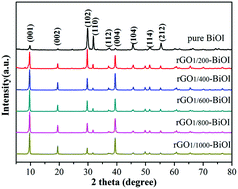Band gap engineering of BiOI via oxygen vacancies induced by graphene for improved photocatalysis†
Abstract
A reduced graphene oxide–bismuth iodide oxide (rGO–BiOI) composite was prepared by a thermal reduction method. The light absorption edge for rGO–BiOI shifted from 675 nm to 739 nm in comparison with that for pure BiOI. Correspondingly, the band gap for rGO–BiOI is slightly narrowed from 1.87 eV to 1.73 eV compared with that for pristine BiOI. The as-prepared rGO1/400–BiOI composite exhibits remarkably improved photocatalytic performance for the degradation of methyl orange, which is 4.2 times higher than that of individual BiOI. The results of positron annihilation lifetime (PAL) spectroscopy, electron spin-paramagnetic resonance (ESR) spectroscopy and soft X-ray absorption spectroscopy (XAS) demonstrate that there are oxygen vacancies (OVs) and Bi3+–oxygen vacancy associates ( ) in the rGO–BiOI catalyst. It could be deduced that graphene could induce OVs and negatively shift the conduction band for rGO–BiOI, which are favourable for the reduction ability of the catalyst. Our work may provide a new insight into the construction of efficient photocatalysts by defect engineering.
) in the rGO–BiOI catalyst. It could be deduced that graphene could induce OVs and negatively shift the conduction band for rGO–BiOI, which are favourable for the reduction ability of the catalyst. Our work may provide a new insight into the construction of efficient photocatalysts by defect engineering.



 Please wait while we load your content...
Please wait while we load your content...